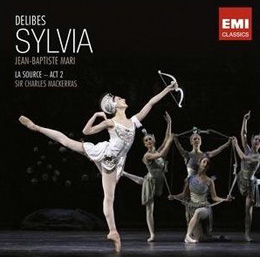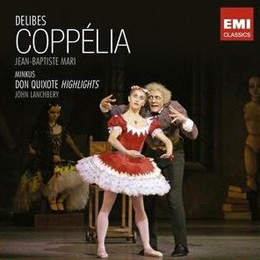| May 1, 2010
Belated Return of Mari’s
Sylvia and Coppélia
 EMI has been bringing back a lot
of its analog recordings lately -- sometimes straightforwardly, just as the respective
recordings originally appeared on LP, and in some cases in huge boxes of "the best
of," which may appeal to some collectors less than to others. Among the recent
revivals, though, are two handsomely packaged two-disc sets which ought to make a lot of
listeners, even the most discriminating ones, very happy: Léo Delibes’s complete
scores for the ballets Coppélia and Sylvia, recorded in 1977 by the
orchestra of the Paris Opéra under the direction of Jean-Baptiste Mari. Each is offered
in a handsomely packaged two-disc set priced at a mere $11.99 USD list. EMI has been bringing back a lot
of its analog recordings lately -- sometimes straightforwardly, just as the respective
recordings originally appeared on LP, and in some cases in huge boxes of "the best
of," which may appeal to some collectors less than to others. Among the recent
revivals, though, are two handsomely packaged two-disc sets which ought to make a lot of
listeners, even the most discriminating ones, very happy: Léo Delibes’s complete
scores for the ballets Coppélia and Sylvia, recorded in 1977 by the
orchestra of the Paris Opéra under the direction of Jean-Baptiste Mari. Each is offered
in a handsomely packaged two-disc set priced at a mere $11.99 USD list.
While few of us had heard of this conductor when these
recordings first appeared on LP, he was obviously a great choice for this material. Love
for the music came through in these recordings, not only on the conductor’s part but
from the altogether exceptional response he drew from the orchestra. Nothing was fudged,
nothing was held back: the strings were sumptuous, the various woodwind solos were
virtuosic in the best sense. Even the horns were simply superb, quite unlike the nasal and
wobbly style associated with Parisian horns until then; their confident depiction of
"Les chasseresses," in Sylvia, was as confidently triumphal as the
humorous scenes. The national dances and nuptial celebration in Coppélia were
irresistibly endearing.
There is no hyperbole in stating that Coppélia,
which had its premiere in 1870, and Sylvia, which came along six years later,
simply revolutionized generally held ideas of the levels "ballet music" might
strive for and attain. Delibes (1836-1891) was not one to be limited by those notions. He
had a far greater imagination than his colleagues who specialized in this field -- a flair
for imagery and expressiveness, a distinctive, original style -- as well as a flair for
infectious tunes, and he was brilliant in his exploitation of the resources of the modern
orchestra. (He was, after Bizet, one of the earliest composers to write for the saxophone,
which has some effective solo passages in Sylvia.) Music of such substance and
character can deliver a high level of pleasure to both those who perform it and those who
make up their audience.
It may also be both stimulating and daunting to fellow
composers. One of the first to recognize this was Delibes’s Russian contemporary
Pyotr Ilyich Tchaikovsky, whose own three great ballet scores -- Swan Lake, The
Sleeping Beauty, The Nutcracker -- took this elevation of status still
further. Some musicians, in fact, regard his Sleeping Beauty as his greatest score
in any form. Like Delibes, Tchaikovsky actually provided music that could sustain itself
even without the stage action it was created to accompany -- a virtually unheard-of
phenomenon until their time, as he himself noted in expressing his admiration for Delibes.
Delibes’s Sylvia was given its premiere in
Paris at just about the time Tchaikovsky completed his score for Swan Lake, and
about a year before that work’s premiere in Moscow. In a frequently quoted letter to
his colleague and former pupil Sergei Taneyev, Tchaikovsky wrote of Sylvia as
"the first ballet in which the music is not only the principal interest, but actually
the only interest. . . . It exudes such charm, such elegance, such abundance of
inventive rhythm and harmony. If I had known this music earlier I would never have dared
to write Swan Lake."
 If you want to know something of the
level on which the specialist "ballet composers" operated before Delibes and
Tchaikovsky entered the field, EMI has provided some edifying examples in the filler
material with these two economical sets. Filling out the second disc of Coppélia (9
67723 2) is nearly a full hour of music from Ludwig Minkus’s Don Quixote
(1869), a ballet still in the repertory of some companies; this is a somewhat more recent
recording, by the Elizabethan Trust Melbourne Orchestra under John Lanchbery. The fillers
in the Sylvia package (9 67713 2) are Act II of La Source, the major part of
Delibes’s contribution to that composite work of 1866, for which Minkus composed all
of Act I and most of Act III, and the Pas de six from another Minkus ballet, Paquita;
Sir Charles Mackerras conducts the Covent Garden orchestra in La Source, while the Paquita
excerpt is performed by the Sydney SO under Lanchbery. If you want to know something of the
level on which the specialist "ballet composers" operated before Delibes and
Tchaikovsky entered the field, EMI has provided some edifying examples in the filler
material with these two economical sets. Filling out the second disc of Coppélia (9
67723 2) is nearly a full hour of music from Ludwig Minkus’s Don Quixote
(1869), a ballet still in the repertory of some companies; this is a somewhat more recent
recording, by the Elizabethan Trust Melbourne Orchestra under John Lanchbery. The fillers
in the Sylvia package (9 67713 2) are Act II of La Source, the major part of
Delibes’s contribution to that composite work of 1866, for which Minkus composed all
of Act I and most of Act III, and the Pas de six from another Minkus ballet, Paquita;
Sir Charles Mackerras conducts the Covent Garden orchestra in La Source, while the Paquita
excerpt is performed by the Sydney SO under Lanchbery.
While the prolific Minkus was eminently successful in his
field, these examples of his most admired works are numbingly uninspired and only serve to
demonstrate why Tchaikovsky or anyone else might have been surprised to come upon ballet
music that was so attractive and fascinating in its own right. We might wish EMI had put
the two Delibes ballets together in a single three-disc set and the Minkus on a single CD
that would appeal more to history buffs than to people who listen to music for the
pleasure it provides, but the return of Mari’s Delibes is no less welcome for the
inclusion of these historical footnotes, especially at such an attractive price.
The Angel LP sets, back in 1977 and ’78, were issued
in the SQ quadraphonic format and sounded just fine in two-channel playback. Fairly early
in the CD era, EMI brought most but not all of this material back in a two-disc budget
set, each CD containing about 75% of the 100 or so minutes of the respective complete
recording -- but, apart from the omissions, those transfers were not at all comparable to
the sound of the original LPs, while these new ones definitely are. (The previously issued
excerpts turn up again, also in upgraded sound, in the Big Ballet Box EMI issued at about
the same time as these two sets of the complete scores, but once you hear any part of
Mari’s recordings you will surely want every note of both works.)
The few complete recordings of Coppélia and Sylvia
on CD that come most readily to mind all happen to be reissues of material originally
brought out on LP. Among these are Antal Doráti’s idiomatic 1957 Coppélia
with the Minneapolis SO (today’s Minnesota Orchestra) and Anatole Fistoulari’s
still very impressive 1958 premiere recording of the complete Sylvia with the
London SO: these were packaged together in a set of three CDs (434 313-2) that ranked high
among the splendid "Living Presence" reissues overseen by the late Wilma Cozart
Fine.
A bit earlier, in the same year Doráti recorded Coppélia,
Decca issued a complete version by Ernest Ansermet and his Orchestre de la Suisse Romande
that was filled with charm, vigor and an obvious affection for the score, if not the last
word in orchestral virtuosity. Decca may have planned to follow up with an Ansermet Sylvia,
but only the usual clutch of excerpts materialized, and the OSR was rather less impressive
in them. (Ansermet’s complete Coppélia and his fragmentary Sylvia are
available now in Australian Eloquence set 460 0083, two CDs.)
Decca chose the OSR again, though, for a remake of Coppélia
under Richard Bonynge, and its lackluster character may have influenced the choice of
the Philharmonia Orchestra for Bonynge’s subsequent complete Sylvia. In any
event, the Philharmonia (called "New Philharmonia" at that time) really came
through for him; Bonynge’s Sylvia is still very persuasive on all counts,
particularly in the two-disc set filled out with the ballet music from Massenet’s
opera Le Cid (425 475-2).
There have also been some outstanding recordings of less
than the full scores. The legendary Pierre Monteux focused the full power of his
experience and enthusiasm on 25 minutes’ worth of the "greatest hits" from
each work with members of the Boston SO -- a very effective monophonic recording that made
it to CD among the Monteux reissues brought out by RCA Victor in 1994 (09026-61975-2, with
the Ballet Music from Gounod’s Faust).
 The most fetching recordings of this
music, however, are neither Monteux’s nor any of the complete sets, but a pair of
monophonic LPs that offered about half the material from each work, conducted by Robert
Irving, the master ballet conductor who succeeded Constant Lambert with the Royal Ballet
and then became music director of the New York City Ballet. Irving’s inspired
realizations of 50 minutes’ worth of Coppélia with the Covent Garden
orchestra and a similarly generous helping from Sylvia with the Philharmonia remain
simply unmatched by any previous or subsequent offering from any source. Both of these LPs
were among the glories of the final years of RCA Victor’s long and productive
trans-Atlantic affiliation with HMV -- and both were favored demonstration discs in the
audio salons of the last pre-stereo years (mid-1950s), the most frequently used tracks
being the "Pas des éthiopiens" in the Sylvia sequence and the
"Musique des automates" in Coppélia. It strikes me as downright unreal
that neither EMI itself nor any of the reissue-specialist labels has brought these
peerless gems back on CD, but they would still be enormously welcome in really first-rate
transfers. The most fetching recordings of this
music, however, are neither Monteux’s nor any of the complete sets, but a pair of
monophonic LPs that offered about half the material from each work, conducted by Robert
Irving, the master ballet conductor who succeeded Constant Lambert with the Royal Ballet
and then became music director of the New York City Ballet. Irving’s inspired
realizations of 50 minutes’ worth of Coppélia with the Covent Garden
orchestra and a similarly generous helping from Sylvia with the Philharmonia remain
simply unmatched by any previous or subsequent offering from any source. Both of these LPs
were among the glories of the final years of RCA Victor’s long and productive
trans-Atlantic affiliation with HMV -- and both were favored demonstration discs in the
audio salons of the last pre-stereo years (mid-1950s), the most frequently used tracks
being the "Pas des éthiopiens" in the Sylvia sequence and the
"Musique des automates" in Coppélia. It strikes me as downright unreal
that neither EMI itself nor any of the reissue-specialist labels has brought these
peerless gems back on CD, but they would still be enormously welcome in really first-rate
transfers.
Meanwhile, that’s exactly what we may say about
EMI’s very attractive re-reissue of the Mari recordings. The new complete
presentations are immeasurably more appealing sonically than the abridged set of the late
1980s, with a welcome bloom on the strings and very effective delineation of the various
winds and brasses -- not to mention the large and small percussion instruments. There is
no reference to "Abbey Road Technology" or, for that matter, any information on
where or by whom the remastering was done, but it is eminently successful in preserving
the full character of these engaging performances in a spacious, well balanced, altogether
lifelike sonic frame, and Robert Orledge’s annotation manages to be both concise and
genuinely informative.
What the annotation does not provide is any information at
all on Jean-Baptiste Mari, which seems to be hard to come by. I don’t have M.
Mari’s dates; all I know about him is that he was born in Algeria, and performed on
both the cello and the tuba in various orchestras before taking up the baton. EMI followed
up on the success of the two Delibes sets by recording M. Mari on a single LP of music by
Chabrier -- which proved to be quite a disappointment and may have been the final entry in
this conductor’s discography. But many an artist’s reputation has rested on less
than these splendid realizations of Coppélia and Sylvia, now once again
realistic candidates for top honors. At the very least, they are powerful reminders of the
unique allure of this music, and if they only remind you to scout out and compare the few
competing versions, that too is something you may enjoy.
. . . Richard Freed
richardf@soundstagenetwork.com
|